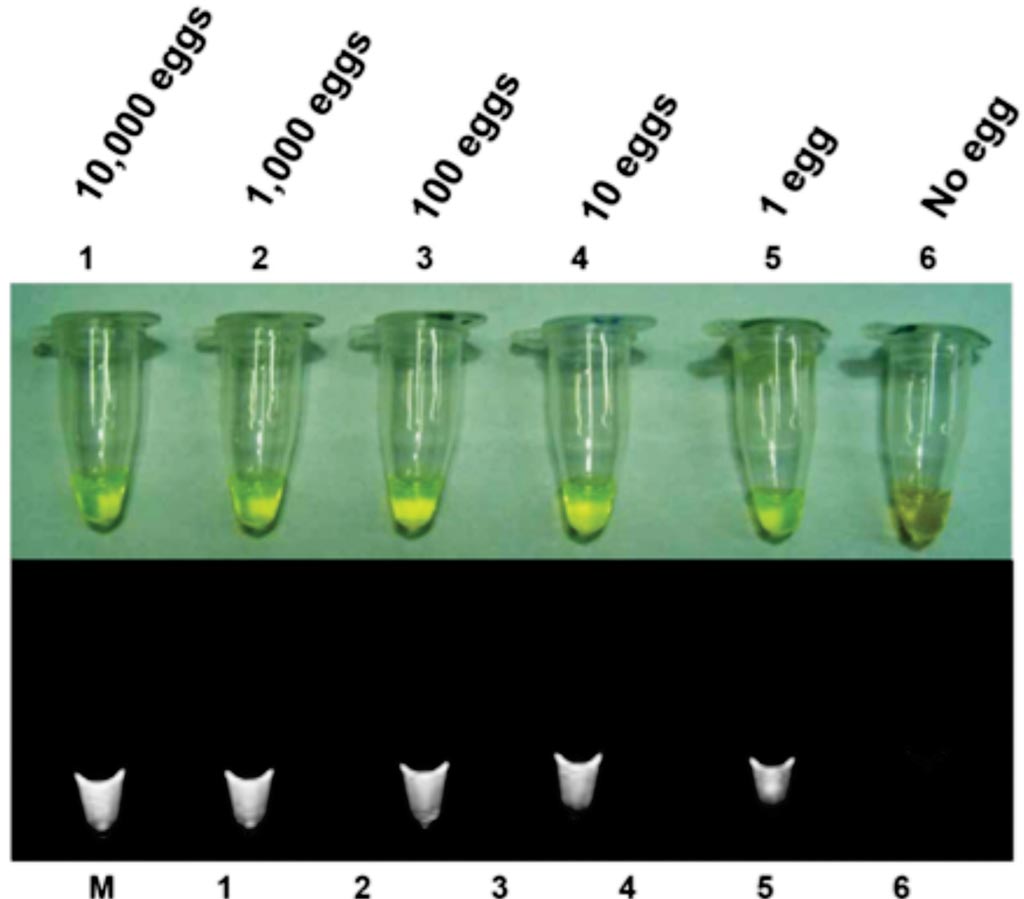LAMP Assay Detects Clonorchiasis in Human Samples
By LabMedica International staff writers
Posted on 26 Oct 2017
Clonorchiasis is prevalent in the Far East, and a major health problem in endemic areas. Infected persons may experience, if not treated, serious complications such as bile stone formation, pyogenic cholangitis, and even cholangiocarcinoma.Posted on 26 Oct 2017
The specific diagnosis of Clonorchis sinensis is important for successful treatment and control of the infection. The Kato-Katz (KK) method and/or formalin-ether concentration technique are commonly used for clonorchiasis diagnosis. However, stool examinations are not highly effective because lightly infected cases can be missed.

Image: Sensitivity of the loop-mediated isothermal amplification (LAMP) assay for the detection of Clonorchis sinensis eggs in feces experimentally spiked with a known number of eggs in ten-fold serial dilutions from 10,000 eggs (lane 1) to one egg (lane 5) (Photo courtesy of Seoul National University Medical Research Center).
Scientists at the Seoul National University Medical Research Center (Seoul, Korea) and their colleagues randomly selected from the pool of stool samples of the residents of Sancheong County in Korea, where clonorchiasis is endemic, and risk factors and incidence of cholangiocarcinoma among this resident were investigated since 2006. For each stool sample, two KK smears and one real-time polymerase chain reaction (PCR) were performed. For the KK smear, 41.7 mg of feces was examined by microscopy and multiplied by 24 to convert to eggs per gram of feces (EPG).
A loop-mediated isothermal amplification (LAMP) assay was applied for the detection of Clonorchis sinensis DNA. Six primers targeting eight locations on the cytochrome c oxidase subunit 1 gene of C. sinensis were designed for species-specific amplification using the LAMP assay. Amplified LAMP products were detected directly either by the naked eye or by placing the reaction tube under UV light. In addition, 5.0 μL of the LAMP products was examined by electrophoresis on a 2% agarose gel, followed by ethidium bromide staining and visualization under UV light.
The LAMP assay was sensitive enough to detect as little as 100 fg of C. sinensis genomic DNA and the detection limit in 100 mg of stool was as low as one egg. The assay was highly specific because no cross-reactivity was observed with the DNA of other helminths, protozoa or Escherichia coli. Then, the LAMP assay was applied to human fecal samples collected from an endemic area of clonorchiasis in Korea. Using samples showing consistent results by both Kato-Katz method and real-time PCR as reference standards, the LAMP assay showed 97.1% of sensitivity and 100% of specificity. In stool samples with more than 100 eggs per gram of feces, the sensitivity achieved 100%.
The authors concluded that they had developed a highly sensitive and specific LAMP assay for detection of C. sinensis DNA in human fecal samples. Due to the shorter reaction time and better visual judgment of positivity without requiring sophisticated instruments, the LAMP assay can be more easily applied in field laboratories than PCR as a powerful tool for more specific and reliable diagnosis of clonorchiasis, thereby improving both treatment and control programs. The study was published on October 9, 2017, in the journal Public Library of Science Neglected Tropical Diseases.
Related Links:
Seoul National University Medical Research Center













